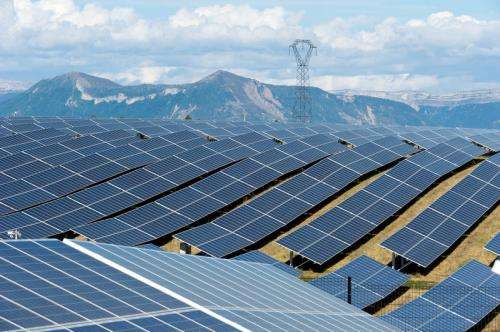Neutron investigation into self-assembling solar-harvesting films reveals new low-cost tool for 3-D circuit printing

Scientists from Imperial College London, working at the Institut Laue-Langevin, have presented a new way of positioning nanoparticles in plastics, with important applications in the production of coatings and photovoltaic material that harvest energy from the sun. The study, presented in Advanced Materials (cover article), used neutrons to understand the role that light – even ambient light – plays in the stabilisation of these notoriously unstable thin films. As a proof of concept the team have shown how the combination of heat and low intensity visible and UV light could in future be used as a precise, low-cost tool for 3D printing of self-assembling, thin-film circuits on these films.
Thin films made up of long organic molecule chains called polymers and fullerenes (large football-shaped molecules composed entirely of carbon) are used mainly in polymer solar cells where they emit electrons when exposed to visible or ultraviolet sun rays. These so-called photovoltaic materials can generate electrical power by converting solar radiation into direct electrical current.
Polymer solar cells are of significant interest for low-power electronics, such as autonomous wireless sensor networks used to monitor everything from ocean temperature to stress inside a car engine. These fullerene-polymer mixtures are particularly appealing because they are lightweight, inexpensive to make, flexible, customisable on the molecular level, and relatively environmentally-friendly.
However current polymer solar cells only offer about one third of the efficiency of other energy harvesting materials, and are very unstable.
In order to improve science's understanding of the dynamics of these systems and therefore their operational performance, the team carried out neutron reflectometry experiments at the ILL, the world's flagship centre for neutron science, on a simple model film made up of pure fullerenes with a flexible polymer. Neutron reflectometry is a non-destructive technique that allows you to 'shave' layers off these thin films to look at what happens to the fullerenes and the polymers separately, at atomic scale resolution, throughout their depth.
Whilst previous theories suggested that thin film stabilisation was linked to the formation of an expelled fullerene nanoparticle layer at the substrate interface, neutron reflectometry experiments showed that the carbon "footballs" remain evenly distributed throughout the layer. Instead, the team revealed that the stabilisation of the films was caused by a form of photo-crosslinking of the fullerenes. The process imparts greater structural integrity to films, which means that ultrathin films, (down to 10000 times smaller than a human hair) readily become stable with trace amounts of fullerene.
The implications of this finding are significant, particularly in the potential to create much thinner plastic devices which remain stable, with increased efficiency and lifetime (whilst the smaller amount of material required minimises their environmental impact).
The light sensitivity also suggests a unique and simple tool for imparting patterns and designs onto these notoriously unstable films. To prove the concept the team used a photomask to spatially control the distribution of light and added heat. The combination causes the fullerenes to self-assemble into well-defined connected and disconnected patterns, on demand, simply by heating the film until it starts to soften. This results in spontaneous topography and may form the basis of a low-cost tool for 3D printing of thin film circuits. Other potential applications could include patterning of sensors or biomedical scaffolds.
In the future, the team is looking to apply its findings to conjugated polymers and fullerene derivatives, more common in commercial films, and industrial thin film coatings.
More information: Advanced Materials Volume 25, Issue 7, pages 985–991
Journal information: Advanced Materials
Provided by Institut Laue-Langevin




















